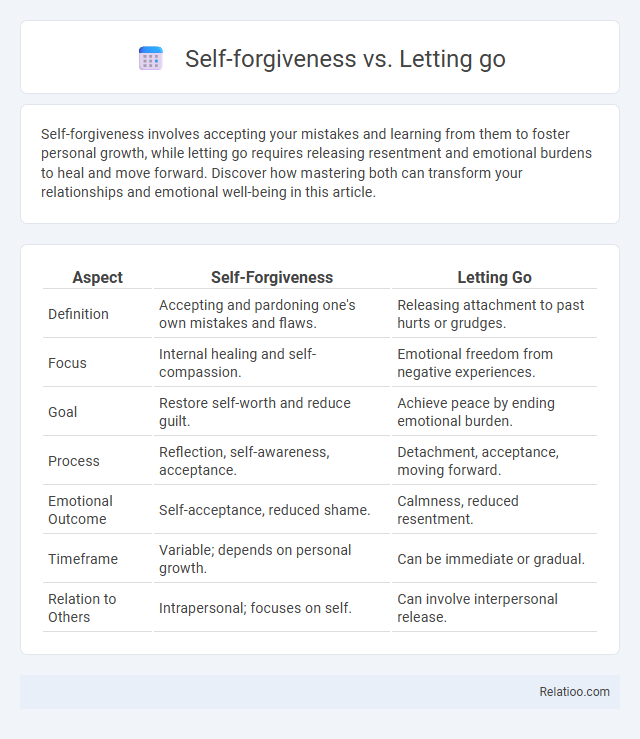Self-forgiveness involves accepting your mistakes and learning from them to foster personal growth, while letting go requires releasing resentment and emotional burdens to heal and move forward. Discover how mastering both can transform your relationships and emotional well-being in this article.
Table of Comparison
| Aspect | Self-Forgiveness | Letting Go |
|---|---|---|
| Definition | Accepting and pardoning one's own mistakes and flaws. | Releasing attachment to past hurts or grudges. |
| Focus | Internal healing and self-compassion. | Emotional freedom from negative experiences. |
| Goal | Restore self-worth and reduce guilt. | Achieve peace by ending emotional burden. |
| Process | Reflection, self-awareness, acceptance. | Detachment, acceptance, moving forward. |
| Emotional Outcome | Self-acceptance, reduced shame. | Calmness, reduced resentment. |
| Timeframe | Variable; depends on personal growth. | Can be immediate or gradual. |
| Relation to Others | Intrapersonal; focuses on self. | Can involve interpersonal release. |
Understanding Self-Forgiveness
Understanding self-forgiveness involves recognizing personal mistakes without harsh judgment, allowing emotional healing and growth. Unlike simply letting go, self-forgiveness requires active acknowledgment of wrongdoing coupled with compassion toward oneself. This process restores inner peace and fosters resilience by breaking cycles of guilt and self-blame.
The Essence of Letting Go
Letting go centers on releasing attachment to past pain, regrets, or control, enabling emotional freedom and inner peace. Unlike self-forgiveness, which involves accepting one's mistakes and showing compassion toward oneself, letting go transcends personal judgment, focusing on detachment from negative emotions and experiences. The essence of letting go lies in surrendering resistance to what cannot be changed, fostering healing and growth beyond self-blame.
Key Differences: Self-Forgiveness vs Letting Go
Self-forgiveness involves acknowledging personal mistakes, accepting responsibility, and releasing self-blame to restore inner peace and foster emotional healing. Letting go emphasizes detaching from past hurts, resentment, or negative emotions without necessarily addressing internal guilt or self-judgment. The key difference lies in self-forgiveness directly targeting internal accountability and self-compassion, while letting go centers on freeing oneself from external emotional burdens or attachments.
Emotional Impact of Self-Forgiveness
Self-forgiveness involves actively acknowledging your mistakes and releasing self-directed negativity, which promotes emotional healing and reduces feelings of guilt and shame. Letting go focuses more on detaching from painful memories or emotions without necessarily addressing underlying self-judgment, often providing temporary relief but less deep emotional repair. Embracing self-forgiveness can transform your emotional landscape by fostering self-compassion, resilience, and long-lasting inner peace.
The Healing Power of Letting Go
The healing power of letting go lies in releasing emotional burdens and unresolved pain, which fosters inner peace and mental clarity. Self-forgiveness involves acknowledging mistakes and embracing compassion to rebuild self-worth, while letting go emphasizes detachment from past hurts and grudges to promote emotional freedom. Together, these practices facilitate profound healing by transforming negative emotions into acceptance and renewal.
Steps to Practice Self-Forgiveness
Self-forgiveness involves acknowledging your mistakes, accepting responsibility without harsh self-judgment, and understanding that imperfection is part of being human. Letting go requires releasing resentment and negative emotions tied to past events to regain inner peace and emotional balance. To practice self-forgiveness effectively, you can reflect on your actions, write a compassionate letter to yourself, and commit to positive change while embracing self-compassion and personal growth.
Strategies for Letting Go
Effective strategies for letting go involve mindful acceptance, where you acknowledge your emotions without judgment, creating space for healing and growth. Practicing self-reflection helps identify underlying attachments or resentments, enabling you to release them consciously and cultivate emotional freedom. Incorporating techniques like meditation, journaling, or therapeutic conversations supports the gradual process of detaching from past experiences, empowering your path toward inner peace and personal transformation.
Common Barriers to Both Processes
Common barriers to both self-forgiveness and letting go include deeply ingrained guilt, fear of vulnerability, and the resistance to change personal narratives. Emotional attachment to past mistakes can prevent you from embracing self-compassion and fully releasing negative emotions. Overcoming these obstacles often requires intentional reflection and the development of new coping strategies to foster healing.
Integrating Self-Forgiveness and Letting Go
Integrating self-forgiveness and letting go involves embracing personal accountability while releasing lingering guilt and resentment to foster emotional healing. Self-forgiveness requires acknowledging mistakes and showing compassion toward oneself, whereas letting go emphasizes the process of detaching from past hurts and limiting beliefs. Together, these practices create a holistic approach to mental wellness by promoting inner peace, resilience, and a forward-focused mindset.
Choosing the Right Path for Personal Growth
Choosing the right path for personal growth involves understanding the distinctions between self-forgiveness, letting go, and their combined practice. Self-forgiveness requires acknowledging mistakes and releasing self-judgment, fostering emotional healing and inner peace. Letting go emphasizes detachment from past hurts or negative emotions, creating space for renewed focus and growth.

Infographic: Self-forgiveness vs Letting go
 relatioo.com
relatioo.com